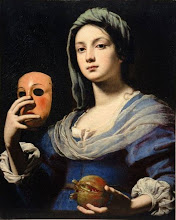"After seven days in the meadow the souls and Er were required to travel further. After four days they reached a place where they could see a rainbow shaft of light brighter than any they had seen before. After another day's travel they reached it. This was the spindle of Necessity. Several women, including Lady Necessity, her daughters and the Sirens were present. The souls were then organized into rows and were each given a lottery token apart from Er."
From the Myth of Er, ascribed to Socrates by Plato.
This image of a rainbow spindle spinning out reincarnations, recalls the Kundalini, from Yoga tradition, a divine energy associated with the Goddess.
 William Blake, illustration for the poem Jerusalem.
William Blake, illustration for the poem Jerusalem.
On the right a woman with the moon (feminine principle), spins a thread emerging from the crown of the head of a divine creator figure.
In yoga philosophy, the Kundalini shakti emerges through an aperture at the crown of the head, called the Brahmarandra (rent of Brahma).
Jerusalem is a symbol of the Sahasrara and the Eternal Self.
"Myths of weaving exist around the world as metaphors for creation."
"The spindle is often an axis mundi and its whirling whorls serve a cosmogonic function. Plato, for example, had a vision of the great goddess Ananke, "Necessity," spinning the universe; the sun, moon, and planets were her spindle's whorls; sirens sang through the webs of time and fate that she wove, and souls endlessly moved through the strands on their way to and from death and rebirth. Many goddesses are spinners and weavers: the Fates of ancient Greece; Athena, also of Greece; Neith of ancient Egypt; in Teutonic myth the Norns spin secret meanings into life."
The Norse goddess Frigg






















